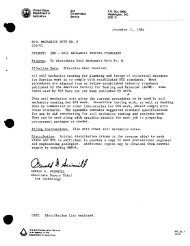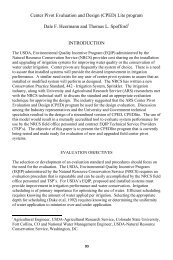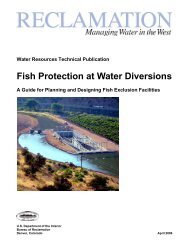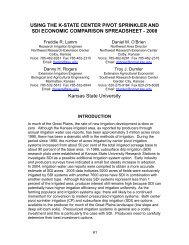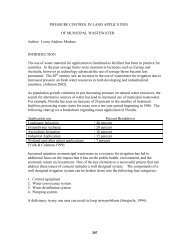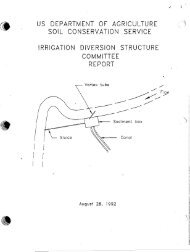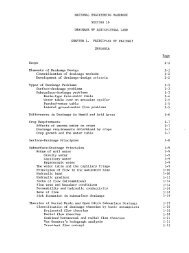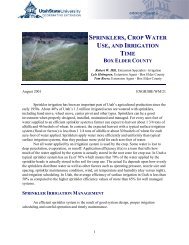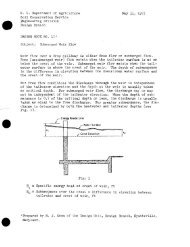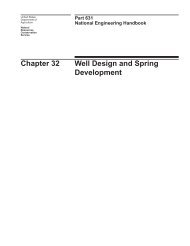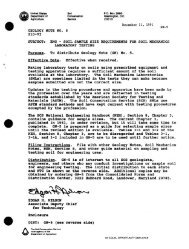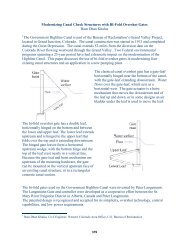Chapter 11: Sprinkle Irrigation - NRCS Irrigation ToolBox Home Page
Chapter 11: Sprinkle Irrigation - NRCS Irrigation ToolBox Home Page
Chapter 11: Sprinkle Irrigation - NRCS Irrigation ToolBox Home Page
Create successful ePaper yourself
Turn your PDF publications into a flip-book with our unique Google optimized e-Paper software.
The leading manufacturers of sprinklers are mntinually<br />
field testing their products, and data are<br />
available on several sprinklers operating under various<br />
field conditions. When planning sprinkle irrigation<br />
systems, request such data from the distributors<br />
or manufacturers. If available, the data should<br />
be used as a basis for selecting the combination of<br />
spacing, discharge, nozzle size, and operating pressure<br />
that will result in the highest practical uniformity<br />
coefficient for the existing operating conditions.<br />
Spacing.--The basic criterion governing the selection<br />
of spacing for any given sprinkler nozzlepressure<br />
and wind combination is the uniformity of distribution<br />
desired. Tn general, a CU of about 85 percent<br />
is recommended for delicate and shallow-rooted<br />
crops such as potatoes and most other vegetables.<br />
A CU above 75 percent is generally adequate for<br />
deep-rooted field crops such as alfalfa, corn. cotton,<br />
and sugar beets. Tree and vine crops that have deep<br />
spreading root systems can be adequately irrigated<br />
if the CU is above 70 percent. When applying chemicals<br />
through the system, however, a CU above 80<br />
percent is recommended. When systems have low<br />
CUs due to wind, chemicals should be applied only<br />
during calm periods,<br />
Table <strong>11</strong>-7 gives a more useful meaning to the<br />
concept of CU. From table <strong>11</strong>-7, if a sprinkle<br />
system has a CU of 86 percent, for each inch of<br />
gross application received by the crop or soil, 80<br />
percent of the area would receive at least 0.85 in. If<br />
the CU were only 70 percent, 80 percent of the area<br />
would receive at least 0.68 in. To apply a net application<br />
of 1.0 in to at least 80 percent of the area<br />
with a system having a CU of 86 percent, a gross of<br />
1.0 divided by 0.85 = 1.18 in plus wind drift and<br />
evaporation losses must be applied. With a CU of<br />
only 70 percent, a gross after drift and evaporation<br />
losses of 1.0 divided by 0.68 = 1.47 in would be required.<br />
Figure <strong>11</strong>-27 illustrates the relation between rainfall<br />
area and depth of water applied at the CU<br />
values discussed above. Both 70 and 86 percent CU<br />
values leave 20 percent of the area underirrigated,<br />
and 80 percent of the area adequately or overirrigated.<br />
However, this requires a gross application of<br />
approximately 25 percent more water with the 70<br />
percent CU than with the 86 percent CU. Data for<br />
constructing figure <strong>11</strong>-27 were taken from table<br />
<strong>11</strong>-7.<br />
Table IL-7.--Minimum depth of water applied per 1.0 in<br />
gross application for various values of CU and percentages<br />
of land area adequately irrigated<br />
Percent of area adequately irrigated<br />
CU<br />
percent 95 90 85 80 75 70 65 60<br />
(inch)<br />
90 0.79 0.84 0.87 0.89 0.92 0.93 0.95 0.97<br />
86 .71 .78 .82 .85 .88 .91 .93 .96<br />
82 .63 .71 .77 .81 .85 38 .91 .94<br />
78 .55 .65 .71 .77 .81 .86 -89 .93<br />
74 .46 .58 .66 .73 .78 .83 .88 .92<br />
70 .38 .52 .61 .68 .75 .80 .86 .91<br />
AREA RECEIVING LESS INDICATED DEPTH . PEnCENT<br />
Figure <strong>11</strong>-27.-Relationships between surface area and depth of<br />
water applied for CU values of 70 and 86 percent when 20 percent<br />
of the area is underirrigated and the remaining 80 percent<br />
of the area is adequately (or over) irrigated.<br />
When any given CU value is used as the irrigation<br />
application efficiency, the area adequately<br />
irrigated will be approximately 80 percent, i.e., note<br />
that the values under the 80 percent adequacy<br />
column correspond almost perfectly with the values<br />
under the CU column.<br />
When three or more adjacent laterals are operated<br />
simultaneously in a fixed or block-move system, the<br />
wind drift and evaporation losses are minimized<br />
and essentially all of the water is applied effectively.<br />
Therefore, table <strong>11</strong>-7 can be used to approximate<br />
overall irrigation efficiency for "block<br />
system" layouts.<br />
Table <strong>11</strong>-8 gives a better understanding of CU<br />
and shows the relative productivity, especially<br />
when dealing with shallow-rooted vegatative crops



